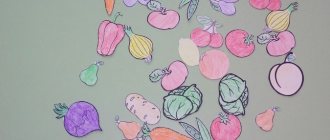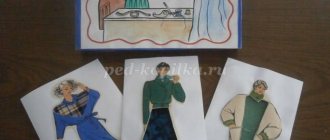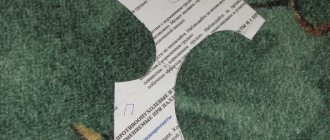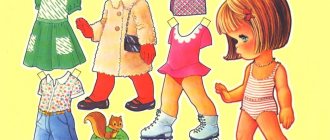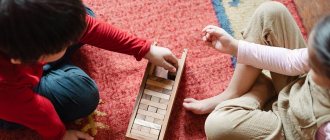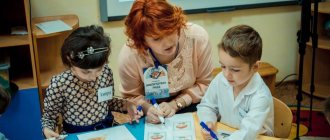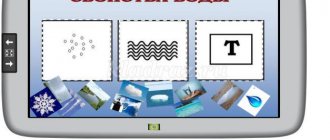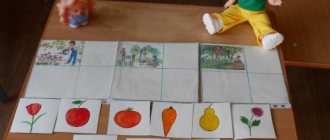Didactic game "Matryoshka" in the younger group
The purpose of the didactic game “Matryoshka” is to teach the skill of working with a three-dimensional object, selecting and combining its components. This game, like the others, reinforces the idea of a national souvenir toy and fosters respect for folk art.
For the lesson, you need a split toy about 10 cm high. The teacher demonstrates it and explains how it opens to remove the next toy. When all the nesting dolls have been removed, the teacher shows the preschooler how to correctly assemble them in reverse order, and how to close the toy so that its upper and lower halves match the pattern on the apron.
Didactic game for children 3-7 years old. Funny Matryoshkas
Didactic game for preschoolers
Purpose: To develop attention, thinking, imagination. Material: sheets of white paper, cardboard: yellow, red, green; pva glue, scissors, watercolor, brush, varnish. Making: I drew thirty nesting dolls - fifteen pairs. Decorated with watercolors. Every ten nesting dolls were glued onto cardboard of a different color: yellow, red, green. Cut it out. Then I coated it with varnish. Didactic game "Funny Matryoshkas" - a universal game. Children 3-7 years old can play it, just like during classes. and in your free time. A cheerful toy - a painted matryoshka - was born 100 years ago. It was invented by the artist Sergei Vasilyevich Malyutin. Among the Japanese children, he saw a toy - the old sage Daruma. It was a tumbler toy. Inside it was another similar Daruma doll, only smaller. And the artist invented a doll for Russian children that looked like the Japanese Daruma. And the doll was unusual, with a wonderful surprise: inside each doll sat a smaller doll, and in that one an even smaller one, and another, and another... (Shows the nesting doll.) S.V. Malyutin dressed each doll in a painted sundress, a bright scarf and a colorful apron. And they called this doll Matresha, an old Russian name, after a kind, beautiful girl who worked in the artist’s house. This is how the matryoshka doll was born - a detachable wooden doll. The most suitable material is dry linden or birch, as it is very soft and can be easily cut with a knife. Wood blanks were sanded and then painted by artists. I offer several options. Option 1. Find a mate for each matryoshka.
Option 2 . Find 2 identical nesting dolls.
Option 3. Find differences. From two nesting dolls:
From three nesting dolls:
etc. Option 4. Fix the names of the colors: yellow, red, green.
There are many more options for using “Merry Matryoshka” during game programs
We recommend watching:
Didactic games for children of the first junior group Didactic games with buttons for children 3-4 years old Educational games with Dienesha blocks in the junior group Do-it-yourself didactic manual “Draw paths” for the junior group
Similar articles:
Didactic games on physical development in the 2nd junior group of preschool educational institutions
Methods of using didactic games in kindergarten in the junior - middle group
Didactic games for developing the abilities of preschoolers 3-5 years old to identify the properties of objects
Didactic game for children 4-7 years old “Fairytale Hotel”
Game layout for children 4-7 years old “My City”
Count the nesting dolls
The game is optimal for improving mathematical knowledge in middle school preschoolers and strengthening counting skills.
The teacher lays out nesting dolls of different sizes in random order. The child’s task is to put the toys in a row according to size - first from largest to smallest, then in reverse order, counting their number.
Find the halves
For the game you need images of nesting dolls, divided transversely in half. The teacher lays out parts of the pictures in front of the player and asks him to assemble the toys into a single whole. It is important that the preschooler tries to combine the halves not only in size, but also in color and pattern on the apron.
For younger preschoolers, it is enough to take 2-3 pairs of parts; for students in the middle age group, you can increase the number of pictures.
Didactic game “Assemble a nesting doll”
The game, intended for younger preschoolers, teaches how to compose images according to the principle of puzzles and identify the component parts. The lesson requires cardboard images of nesting dolls, cut into several arbitrary pieces.
The player tries to assemble an image from parts. If there are several children, the game can be made competitive: the winner is the player who collects his picture first.
Didactic game “Dress up the matryoshka”
The game teaches you to see beauty and fosters a love of creativity. The goal is to learn the skill of laying out patterns according to a template.
For the lesson, you need large images of nesting dolls without patterns on the apron and scarf, as well as small template images with different decor options. Separately, it is necessary to cut out multi-colored floral patterns and geometric shapes with which children will decorate aprons and scarves. The game task for the younger group is to lay out patterns according to the provided templates. Older children can be encouraged not to use templates, but to come up with a beautiful pattern themselves.
Summary of the game for the 2nd junior group. Let's collect nesting dolls
Abstract: the game “Let's collect nesting dolls” for the second junior group
Introduction: In play activities of any form, the play qualities of the child’s personality are formed; The game improves the skills acquired in classes, develops memory, and encourages responsibility for the assigned task. Preschool children acquire knowledge much more successfully through play than in class. They understand the meaning of the game, they are interested in it. Preschoolers do not notice difficulties in the game, they themselves find the right solution in the game, they show interest in the role of the leading character. In preschool age, it is necessary to teach games related to life situations. During the game, the teacher should not be very active; his task is only to monitor its progress. Educational games provide the child with physical and mental activity, teach him to think, quickly respond to new things, and reinforce the old. The rules of behavior outside the game are poorly understood by children, while during the game they manage their actions well. Children are required to strictly follow the conditions of the game so that the teacher is satisfied and their peers recognize these actions in the game as correct. Goals: educational, developmental. Objectives: acquiring new knowledge, replenishing vocabulary, demonstrating resourcefulness, developing spatial orientation in children - distinguishing between the top and bottom of an object; development of coordination of small movements of the hands. Game material and visual aids: - two-seater nesting dolls with bright colors. Form of lesson: play combined with conversation. The teacher invites the children to look at the double dolls and explains to the children that they need to be disassembled, then correctly assembled and folded the small doll into a large doll, observing the correct position of the doll (head up). Children must learn to distinguish where the bottom is and where the top of the toy is. The words (bottom) and (top) are not yet clear to them. Children, with the help of the teacher, try to understand this and learn these expressions. The teacher and the children examine the nesting doll and ask the children questions: Children, please show me where the head of the nesting doll is? That's right, where the handkerchief is! Children, this means the top part of the nesting doll! Guys, tell me, where is the lower part of the nesting doll? Absolutely right, where the pocket on the dress is. Well done boys. Based on the design of the toy, children can name other familiar signs. You can use a three-seater matryoshka doll in the activity.
We recommend watching:
Didactic games for children of the first junior group Didactic games with buttons for children 3-4 years old Educational games with Dienesha blocks in the junior group Do-it-yourself didactic manual “Draw paths” for the junior group
Similar articles:
Didactic games on physical development in the 2nd junior group of preschool educational institutions
Methods of using didactic games in kindergarten in the junior - middle group
Didactic games for developing the abilities of preschoolers 3-5 years old to identify the properties of objects
A toy shop
Through the game intended for the older group, preschoolers learn about the matryoshka doll as an object of arts and crafts, learn to comprehensively and competently describe objects based on external features, and express and explain opinions. The lesson promotes the development of speech skills and concentration, and fosters a respectful attitude towards craft activities.
For the game you need to prepare images of nesting dolls with different types of painting. The teacher lays out the images on the “store counter”. One child becomes the seller, the rest of the players become buyers. The game consists of 3 stages:
- Each player takes turns taking the picture he likes and describing it in detail. You can’t repeat yourself when choosing a toy.
- The seller describes the picture. And buyers must guess what we are talking about.
- The player approaches the seller, describes the toy he wants to buy, but does not indicate it. The seller must guess which picture they want to buy from him.
Travel game “Russian nesting doll”
(middle group)
Target:
- to form children’s ideas about the Russian nesting doll as one of the ancient folk crafts;
— continue to enrich children’s understanding of folk art;
- develop aesthetic perception of folk art objects;
— develop the need and ability to independently master the world around us by studying cultural heritage;
- develop visual memory, thinking, spatial imagination, perception of size and counting;
— to develop children’s ability to write short descriptive stories; enrich vocabulary
- develop the ability to participate in joint games;
- cultivate independence and activity.
Equipment: nesting dolls, envelopes with cut-out pictures.
Progress of the game
Educator: Children, let's play with you? Today we will go on a journey. But we will not travel alone, but with our guests. (Music sounds, a matryoshka doll comes out). Guys, this is our main guest! Let's say hello and wish each other good health.
Who came to us? How do you think? (children's answers).
Matryoshka:
A scarlet silk scarf, a bright sundress with flowers, a hand resting on the wooden sides. And there are secrets inside: Maybe three, or maybe six. I got a little flushed. This is Russian...
Children: Matryoshka!
Educator: Well done, guys! Our traditional toy, the nesting doll, is known not only in our country, Russia, but also far beyond its borders. Not only do children all over the world play with matryoshka dolls, but people also give them to each other as a souvenir - a small gift from Russia. To make a nesting doll, a tree is used - birch or linden. The figurine is then processed and painted into two parts, painted, decorated and varnished.
Matryoshka: Guys, today we have a trip to the Russian nesting doll museum. Do you want to see a lot of interesting things? Let's hit the road!
Music is playing
P/i "Train"
Children line up one after another, holding onto the belt of the child in front. Each child is a carriage, and the one standing in front is a locomotive.
Educator: Guys, we have arrived at the museum of Russian craftsmen. What do you see here (matryoshka dolls), and what is a matryoshka doll? (toy) What are they made of? (It's made of wood) That's right! The figurine is disassembled into 2 parts, and in it there is another figurine, similar to the first, only a little smaller, and in it there is also another... (The teacher takes apart the nesting dolls.) Look, all the nesting dolls are mixed up.
D/i “Find the legs of the nesting doll”
Children must assemble the nesting dolls correctly.
Educator: Guys, let's count how many nesting dolls there are (five). Are all the toys the same height? (children's answers)
Matryoshka: Let's look at my outfit. (Children look at the matryoshka doll. Describe it)
Educator: Correct! Our Matryoshka is dressed in a painted sundress, scarf, and apron. Now I will allow you to take one nesting doll from the museum and tell us about your toy. (Children write short descriptive stories).
Educator: Let's put our nesting dolls in place and rest a little.
Game “We are funny Matryoshkas”
Funny nesting dolls, (Clap their hands)
Boots on feet, (Hands on waist, alternately place foot on heel forward)
Variegated sundresses, (Hands on the belt, turns the body to the right - left)
Bright handkerchiefs, (Tilts the head left - right)
We love to dance (Stomping feet)
Our cheeks are flushed, (rub our cheeks)
We are funny nesting dolls,
We look like sisters. (Clap their hands)
Matryoshka: Guys, I have a surprise for you - interesting pictures. You need to collect them.
D/ game “Funny nesting dolls”
Divide the children into teams. Give each team an envelope with a cut-out picture. Task: who can put the picture together correctly?
Matryoshka: What did you do (children’s answers). Well done boys.
Educator: What did we see in the museum?
What is the nesting doll made of?
What is she wearing?
Well done, the nesting doll is our traditional toy, which is known all over the world.
Guys, now let's say goodbye to the guests and invite them back to our kindergarten to play and have fun.
Matryoshka
The game, intended for middle preschool age, develops mathematical and speech skills and improves tactile perception. Its goal is to consolidate ideas about colors, sizes, spatial distribution, number of objects, expand thematic vocabulary, and develop the skill of answering questions competently. The activity promotes the development of fine motor skills and visual, in particular color, perception, and develops the skill of systematizing objects and distributing them by size.
To play, you need to make 7 nesting dolls, corresponding to the colors of the rainbow, with the image of a certain geometric figure on the apron. Each toy has a certain type of fastener: zipper, button, button, silk ribbon, lace, Velcro tape, buckle. You also need award chips and small decorative items: beads, rings, buttons, figurines, badges.
By playing with a red doll, a preschooler reinforces the idea of the number 1 and the square shape, and gains the skill of zipping up zippers. For the orange toy, the number 2, rectangle and button are relevant. For yellow - 3, circle, button. For green - 4, triangle, silk ribbon. For blue - 5, diamond, lace. For blue - 6, oval, Velcro tape. For purple - 7, polygon and buckle.
You can play with the presented material in different ways and come up with your own rules. The game can be individual or group. Here are some options:
- Make a series of nesting dolls according to the size and colors of the rainbow.
- Dress up the dolls using small decor in quantities corresponding to the number on the apron.
- The toys are in the correct order. The players close their eyes. The teacher hides the matryoshka doll. The pupils, opening their eyes, try to remember which toy has disappeared.
- The toys are arranged in the correct order. The students close their eyes. The teacher changes the location of the two toys. Opening their eyes, the players say what has changed.
For preschoolers of the younger group, it is advisable to place no more than 5 dolls in a row.
The player with the most chips for correctly completed tasks wins. If the game was individual, the player who completed the tasks should be encouraged.
How to teach a child to assemble a three-seater nesting doll?
Typically, children learn to assemble a three-person nesting doll between the ages of 1 year 9 months and 2 years. We will need three nesting dolls with a difference in size of 3-4 cm, for example, a small matryoshka can have a size of 4-6 cm, a large one - 7-9 cm, a large one - 10-12 cm). If your child has never played with a nesting doll before, it is best to use it as the smallest one-piece nesting doll in the set.
If the child easily copes with this task, complicate it with matryoshka dolls that differ from each other in height by 1.5-2 cm.
Step 1. Give your child three nesting dolls and ask them to show you the biggest one, the smallest one, the smallest one. Let the child study them carefully. Ask him to line up the nesting dolls in a row: first the small one, then the big one, then the big one.
Step 2. Then invite the child to open the nesting dolls and ask each matryoshka to give it a “skirt” (put the bottom of the nesting dolls - their “skirts” in front of the top). If you have difficulty, show yourself how to do it.
Tell them that the nesting dolls really want to try on their “skirts” and ask the child to help them. “Where is our skirt for the largest nesting doll? Let's help and put a skirt on the matryoshka. Where is the skirt for the smallest nesting doll? Choose a skirt for the smallest nesting doll. These are beautiful nesting dolls!”
Step 3. Then ask the child to “hide the nesting dolls” (i.e. collect the nesting dolls). It may not be easy for your baby at first, so he will need your help and a show. Sometimes you may need to hold her hand and perform the desired action with your child's hand.
In the future, repeating the game with nesting dolls, the child will become more independent. It should be taken into account that young children very quickly forget what they have learned, and therefore more repetitions are required (at least 2-3 times on the same task).
Next time, you can conduct a lesson with a matryoshka a little differently, for example like this:
Step 1. Show the three-seater matryoshka doll and shake it. What's rattling? Take the central nesting doll from the nesting doll and place it next to it. How beautiful and smart they are! Ask your child to shake the large and small matryoshka dolls. Oh! It turns out that something is also knocking inside the baby! What is this? Let the child take a smaller doll.
Step 2. Place three nesting dolls in a row - large ones
, small , and between them – on average. Ask your child to show you where the big matryoshka is, where the small one is, and where the middle one is.
Step 3. Assemble the nesting doll. Firstly, you need to put a small one in the middle matryoshka (children often make mistakes in the assembly sequence, so clarify this point: which nesting doll should be hidden first). Show the 2 remaining nesting dolls. So, open the big one and put the middle one inside.
What else to read: Zoo - lesson plan (senior group)
Step 4. Give the child a toy for independent play. Let him take the nesting dolls apart again, arrange the dolls in a row, and then put them in one - “hide.” Help me match the pattern on the matryoshka doll.
Matryoshka, show yourself!
The goal of the game is to develop reaction speed, observation and the ability to act in accordance with the command.
For this activity, you need a small separable doll so that it can be conveniently placed in a child’s palm. Pupils sit on chairs forming a circle. With their hands behind their backs and palms open, the children watch the teacher. And he walks along the circle, bends over to each child, and quietly places half of a nesting doll into the palm of the two players.
Then he gives the command: “Matryoshka, show yourself!” Players who receive a toy in their hand must jump up from their seats and jump into the middle of the circle so that their comrades do not have time to stop them. The task of the other players is to guess who has the hidden parts of the toy and to catch these guys.
Nimble nesting dolls
The proposed didactic game is recommended for working with children 2-4 years old in order to develop sensorimotor perception.
The game contributes to the formation of concepts and ideas about the life of people, their interaction with each other, and also instills interest in Russian culture through familiarity with folk art. Tasks
:
- To consolidate children's knowledge about the three main colors of the toy - matryoshka (red, yellow, green), knowledge one-many.
- Teach children to build a series in descending and ascending order.
- Learn to examine an object by application, overlay.
- Fix in speech the words “high-low”, “lower”, “lowest”, “above”, “highest”, “big-small”, “biggest”, “smallest”.
- Develop memory, attention, observation.
Materials
: a set of matryoshka dolls made of felt and fabric, inside each doll there is a pocket, in addition - a set of felt balls of appropriate size.
Progress of the game
The teacher shows the children a new toy - a nesting doll (all the nesting dolls are located one inside the other) and asks a riddle: The girlfriends are different in height, But they look alike.
They are all sitting next to each other, and there is only one toy. After this, the teacher lays out nesting dolls in front of the children, gives them the opportunity to examine them, and tries to consolidate the children’s knowledge of “one-many.” Then he draws the children’s attention to how bright, elegant, chubby, and ruddy the matryoshka is. Then you can use different game options.
Mothers are looking for daughters
The teacher shows the children a matryoshka doll and says that this is a matryoshka mother. Shows how you can put a matryoshka doll in your pocket, accompanying the actions with the words: “The matryoshka mother is big, and the daughter is small.” The teacher announces to the children that the nesting doll mothers have lost their daughters and calls on them to help their mothers find them. Children complete the task by placing the daughter doll in the pocket of the mother doll. You can hide all the nesting dolls in one big one.
Where are the girlfriends?
The teacher invites the child to choose any of the 5 nesting dolls, except for the largest one, and asks the children to find matryoshka dolls that are larger than her. The child, by application (or overlay), selects nesting dolls and builds a series series.
Who's hiding?
The teacher says that the nesting dolls went for a walk, but one of them got lost. He asks to look carefully at all the nesting dolls, then closes them, removes one, opens them again and asks: “Which nesting doll is lost?” (Answer options: big, small, red, yellow, green, mother, daughter, etc.)
Round dance
The teacher announces: “Our nesting dolls really love to dance in circles. Let's put them in a round dance." You can turn on a song about a matryoshka doll and dance to the music, do a round dance. After this, the teacher asks for each matryoshka to choose a pair by color, and if there are 2 sets, then by size.
Matryoshka dolls are having lunch
For this option, you need to prepare a set of plates - circles of different sizes - in accordance with the number of nesting dolls. The teacher invites the child to choose a suitable plate for each: the largest one for the tallest nesting doll, a slightly smaller one for the next one, etc. Matryoshka dolls play For this option you will need a set of balls. The teacher offers to play ball with the nesting dolls, but all the balls are mixed up, we need to help the nesting dolls find their balls. Matryoshka dolls and balls are laid out on the table, the child picks up a ball for each doll and puts it in his pocket.
It's time to sleep!
The teacher suggests putting the nesting dolls to sleep.
For the game you will need paper strips or squares of different sizes, corresponding to the size of the nesting dolls. The child chooses cribs for the nesting dolls. Maria Blagushko, educational psychologist, MBDOU “Kindergarten
No. 6 “Firefly”, Gadzhievo, Murmansk region.
Funny nesting dolls
For the musical game you need cardboard images of 5 nesting dolls of different sizes and colors. It is also necessary to give the players a pair of wooden musical spoons.
The music teacher places the pictures in a row in front of the children. Introduces the pupils to the dolls: Dashka, Sashka, Glashka, Irinka, Marinka. Explains that the guests love to dance. And the children need to play along with them on a folk musical instrument. Then he taps a different rhythm on the spoons for each nesting doll. And the children repeat. The teacher does not need to use spoons to demonstrate musical rhythm. You can play another instrument, and let the children play along with spoons.
Games with matryoshka dolls for kids
Matryoshka dolls are useful. First of all, this:
- Development of sensory skills (vision, hearing, touch). The child gets acquainted with a variety of sizes and shapes. Using the nesting doll as a rattle, we develop its auditory perception.
- Speech development, attention, logical thinking.
- Development of fine motor skills, coordination of movements.
It's time to share educational nesting doll games with you.
We look for and show the body parts of the nesting doll
First, get to know the nesting doll, describe it, admire its beauty: “This is a matryoshka. Her name is Matryosha. How beautiful! What eyes he has, what a nose, what a mouth, what cheeks! What a gorgeous scarf! The nesting doll has eyes. Where is Vasya...?”
Opening and closing the matryoshka doll
Show your child how to open and close the nesting dolls and how to remove them from each other: “What a heavy nesting doll. What's in a nesting doll? What's thundering inside a mother? Knock-knock, matryoshka! Knock, knock, knock, bye, show us your secret!”
The boys are very curious and are looking forward to continuing. Open the nesting doll and smile every time and be surprised by what you see:
"Oh! Yes, there is a smaller nesting doll. What's there? The matryoshka is even smaller... And here is the smallest nesting doll. There are no more nesting dolls!”
After you have completely disassembled the nesting dolls, assemble them again into a larger one.
Looking for surprises
Children love moments of surprise. You can hide anything you want in a nesting doll: beads, sweets, ribbons. The child will definitely be interested and want to open the nesting doll if he sees a piece of tape peeking out. Fill the nesting dolls with different materials, compare sounds, master the concepts very little. Another game option: teach your child to determine by ear where an object is hidden. We can say that one of the nesting dolls ate a candy, but which one needs to be determined by shaking each nesting doll:
Our dear matryoshka, I wanted to eat it! Mom didn’t listen, but she ate the candy. Where are you, our matryoshka, do you have porridge?
Having found the desired nesting doll, ask the child to wave it with his finger and “feed him porridge.” At the same time you can feed the rest of the nesting dolls. Inside the nesting dolls you can put a different number of objects (for example, plasticine balls). For example, the nesting doll ate 1 candy, the second - two, the third - three. Count the number of items along with the crumbs and match them with the plastic numbers (1,2,3).
We are looking for halves of nesting dolls
We mix the parts of the nesting doll and ask the child to assemble the matching halves. Important! Let your baby make mistakes. Let me put some halves on top of each other, try to stack them, stack them on top of each other, etc. In the course of such actions, he will draw many important conclusions. Let him play as he wants. From time to time I show how to find and connect matching halves.
Comparing nesting dolls
“The nesting doll is big, but this one is small.” You can speak for the nesting doll in several voices:
“I am a big nesting doll” (in a quiet voice). “And I’m a little nesting doll” (loudly) “Wow! Look how many nesting dolls there are. And here is the nesting doll.” We teach older children spatial orientation, with the help of nesting dolls we master concepts such as: many, few; right left; front back; above under; behind-front.
What else to read: Didactic games for the development of phonemic awareness
Find by description
When the child has already learned to play with matryoshka dolls and distinguish them by their main characteristics, you can assign him simple tasks: “Give me a doll that is bigger than this one” “Give me a matryoshka doll that is smaller than this one” “Give me the lower nesting doll of this one “I am a doll in a blue scarf / in a red sundress” “Give me a medium-sized nesting doll” “Give me an open nesting doll” “Give me a nesting doll that rattles” You can also come up with the names of the nesting dolls and ask each one to perform some action: let Masha’s nesting doll jump, Katya’s lie down, Dasha’s will sing a song.
Playing math games
A set of nesting dolls is perfect for role-playing games. You can play daughters - mothers or in medical school... It’s easy to build a table and chairs from cubes and have a tea party. All that remains is to seat the guests and place a plate of treats and a cup in front of each person (individual correspondence). By the way, three-year-old children can complicate the game by asking them to give the nesting dolls plates of different sizes. Matryoshka dolls can be put to sleep (on rectangular beds of a suitable size), rolled into a stroller, in a car, or taken for a walk. To collect nesting dolls for a walk, you need to line them up in a row. Matryoshka is big, for example, mother, and the rest are daughters of different ages. Either the big nesting doll is a teacher, and the other nesting dolls are children in kindergarten. If the child gets confused when lining up a row, place two nesting dolls next to each other and determine which one is taller together. If you have two sets, you can play that the babies are mixed up, and you must place them in pairs, that is, large, medium and small nesting dolls are related to each other (that is, find the same ones). Build nesting dolls (large and small) from bricks or builder and, to your surprise, you will find that a large nesting doll does not look very good in a small house. There are many options! Every day you can stage a new fairy tale.
Painting nesting dolls
In any craft store you can find wooden blanks and paint them with your child. Remember, the main thing is to enjoy the process. Be sure to praise your little one’s creativity!
We arrange the nesting dolls according to the diagram
Schematically drawn nesting dolls (large, medium and small) in different sequences, and the child positions himself. At the same time, we are learning the concept of object projection. We show the child that if you put on a matryoshka doll and search, you will get a pear, and if you put on and search, you will get a circle. You can play that the pears are cribs, and the circles are chairs on which you need to put the nesting dolls.
So many useful educational games with nesting dolls! The matryoshka will be of interest to your baby for a long time, so be sure to buy this wonderful toy. It will not only decorate the interior, but will also help make your child’s free time as productive as possible.
Running errands for a matryoshka
This active competitive game promotes general physical development and teaches one to navigate in space.
Children sit on chairs in a row. The teacher sits against the opposite wall, holding a matryoshka doll in his hands. Gives the command: “Here, to the nesting doll!” Children are running. The one who runs last loses. Then the teacher commands: “Now run back!” The children rush to their chairs. And so on several times until the winner is determined, who was the first to reach the toy more often than others.
Matryoshka is a Russian folk wooden toy, which is a doll, inside of which there are smaller dolls nested one inside the other.
Matryoshka is not just a souvenir. This is an excellent educational toy for a child. With its help you can learn to compare objects by height, width, volume, and teach counting. It develops hand coordination, fine motor skills, and thinking in children.
And besides all other advantages, it has a very interesting story and there is a deep meaning hidden in it. For those who are not interested, you can skip this moment and immediately scroll down to educational games)
The history of the creation of the nesting doll and its essence
According to one legend, it was created in the 90s of the 19th century according to sketches by the artist Sergei Malyutin. And the idea of creating a nesting doll arose thanks to a Japanese toy with the image of the sage Fukurama, which contained several figures nested one inside the other.
The name Matryona, Matresha was considered at that time one of the most common female names, which was based on the word “mother”. Indeed, the matryoshka symbolizes the image of femininity, motherhood, fertility and the infinity of the world. A mother gives birth to a daughter, she gives birth to her daughter, etc. Those. life goes on forever. Thus, the nesting doll with its large family conveys to us the image of the Family, shows several generations of ancestors and descendants.
They say that this toy also contains the idea of searching for truth and the ability to find it by “getting to the bottom”, i.e. to the last matryoshka. Like in the fairy tale about Koshchei the Immortal, remember that one? Koshchei's death was in a needle, a needle in an egg, an egg in a duck, a duck in a hare, etc. Matryoshka also teaches us to look into the depths, not to perceive the world superficially and to learn to see the inner component behind the external. It’s not for nothing that they say, look to the root. This is exactly the same thing.
And the nesting doll seems to be one, but at the same time it consists of many of its manifestations, which are its small reflections. That is, it carries a symbol of unity and at the same time multi-manifestation of our world, the reflection of the small in the large, and the big in the small, the macrocosm in the microcosm and vice versa.
There is also an opinion that the nesting doll shows us the multidimensionality, multi-layered nature of the Universe and man (his chakras, energy bodies: physical, etheric, astral, mental, etc.). And the size of the nesting doll supposedly shows us when a certain human body is formed. For example, various sources indicate that the physical body matures by the first year of life. And the first, smallest nesting doll, is designed to help the baby establish himself in the world of reality; it is associated with the red chakra and should be red. The etheric body is formed by the age of three, it is associated with the orange chakra, so the next nesting doll is larger and orange. The astral body is formed by the age of 7, its color is yellow. The mental body is green and is formed by the age of 12-14. The Blue Matryoshka (throat chakra) is the causal body, which is formed by the age of 21. The blue nesting doll is the body of intuition and spiritual mind, when a person becomes a Father or Mother. And finally, the largest nesting doll, purple, symbolizes the human soul. You realize it best at the age of Grandfather or Grandmother.
The matryoshka dolls should be the same colors. To be honest, I have never seen nesting dolls painted in the colors of the rainbow, but the idea itself is interesting. They say that red is a very powerful color, but it has low vibrations. It attracts you to the earth and allows you to gain its life-giving power. When a person has little of this energy, he has little strength and vitality. Orange color carries the power of fertility. Yellow - health and stability. Green color supports mental strength and intuition. Blue helps communicate with people and gives intellectual strength. Blue helps to understand the laws of the Universe and gives the gift of foresight. And purple harmoniously distributes all energies.
All this is interesting, isn't it? It seems like such a simple toy, but what wisdom and depth lies in it.
How to play with a matryoshka doll?
1. Introducing the matryoshka doll.
In order for a toy to make an impression on a child and for him to want to play with it later, the introduction to it can and should be played out in an interesting way. For example, like this:
We show the nesting doll to the baby: “Look who came to visit us today! This is Matryoshka. What a beautiful dress she has, and what a scarf.” By describing the details of the nesting doll, we lay the foundation for the development of the child’s speech and vocabulary. We examine the Matryoshka together with the baby, show where its eyes, mouth, nose, etc. are, what it is wearing, what color it is.
Then we take it in our hands and say: “How heavy it is.” Let's shake her. “And how it thunders! There's probably something inside there. Let's see what?" We say: “Matryoshka, matryoshka, open up a little,” and open it. Inside the nesting doll we find another matryoshka. Together with the baby we are surprised at what happened. Let's look at the second nesting doll. We put two nesting dolls side by side and compare them. We ask the baby which one is taller and which one is shorter, what one is wearing and what the other is wearing. We tell the child that the matryoshka dolls are similar in shape, but different in size.
Then we invite the child to see if anyone is hiding in the new nesting doll. We pronounce the same words: “Matryoshka, matryoshka, open up a little,” we open it and find another one there. We put them side by side and compare them with the previous ones. We do this until all the nesting dolls come out.
We arrange all the nesting dolls in a row according to height. Please note that each subsequent nesting doll is smaller than the previous one by a head. We look at the nesting dolls, looking for similarities and differences in them.
2. My baby and I learn to open and close nesting dolls.
Be sure to name these concepts: “Let’s open the nesting doll,” “Now let’s close it.”
You can start the game like this. We will hide some surprise for the child in each nesting doll. These can be small toys, sweets (sweets, for example) or pieces of fabric, handkerchiefs. Then we’ll tell the baby that the nesting dolls have prepared gifts for him. “Let's see what gifts the nesting dolls have prepared for you!” If the child is unable to open the nesting doll, we help him. We look at the gifts, say “thank you” to the nesting dolls, and then close them.
When your baby learns to open and close the nesting dolls, you can play a game of finding the halves.
Let's open all the nesting dolls (you can start with two nesting dolls, then add the rest). We tell the baby: “Let’s help each nesting doll find and put on its own skirt.” So, together with the baby, we look for the lower half of each upper half of the nesting doll. And if the half fits, then we close the nesting doll. We make sure to comment on our actions: “This skirt is not suitable for a matryoshka doll, it’s small,” “But this skirt is just right.”
3. We introduce the child to the concepts of “big” - “small”, “high” - “low”.
We put the nesting dolls in a row. We point to each nesting doll and say: “This matryoshka is the largest (high)”, “And this one is smaller”, “This one is even smaller”, etc., “And this one is the smallest (low)”. We talk about the largest nesting doll in a low, weighty voice, and about the smallest one in a high and thin voice. Those. The timbre of our voice shows the difference between them. We give the nesting dolls one by one to the child’s hands so that he can feel their weight and feel the differences between them. When the baby has mastered the concepts, you can ask him to show which matryoshka is the largest and which is the smallest.
You can play the game "Confusion" . We put the nesting dolls in a row according to height, one after another. For example, they went into the forest to pick mushrooms. And on the way back we swap some nesting dolls. “The nesting dolls got their places mixed up. They forgot where (who) they stood behind.” We ask the child to arrange them correctly according to height.
So, in formation (according to height), the nesting dolls can go not only “to the forest to pick mushrooms or berries”, but also just “for a walk”, and also sit around the table to have lunch and dance in circles.
You can make houses for them from boxes or cubes and house them according to their height.
The rings from the pyramid are used to make chairs.
Or make chairs from insert jars of different sizes.
Items for nesting dolls can also be arranged according to their height. The largest nesting doll has the largest mushroom basket, food plate or crib, the smallest one has a small one.
4. We learn to hide nesting dolls inside each other.
To begin with, you can open the largest nesting doll and show your baby how another nesting doll can fit into it. You can take turns hiding the nesting dolls in each other. Thus, the baby will understand that a small nesting doll can be hidden in a large one, but a large one cannot be hidden in a small one.
Let's line up a row of nesting dolls. Let's reveal them all. We will get two rows of “handkerchiefs” and “skirts”. Let's tell the baby: “Let's hide the nesting dolls.” We hide the smallest one in the one next to it and put on a “handkerchief”. Then from the remaining ones we take the smallest one and hide it in the next one, cover it with a “handkerchief”. We give the baby the opportunity to hide the rest of the nesting dolls. So, the baby will understand the principle of assembling a nesting doll.
You can play this game:
We arrange the nesting dolls in a row. We hide one of the nesting dolls in the other. We ask the child to determine by ear where the nesting doll is hidden, in which one? Let him take turns bringing the nesting doll to his ear and shaking it. And when the missing item is found, let him choose the right place for it. Thus, the baby develops auditory perception and spatial thinking.
5. We study the concepts of “far” and “close”.
Let's place some of the nesting dolls close so that you can reach them with your hand. And some are further away. We tell the baby: “Let’s reach for the nesting dolls. They stand close to us and are easy to reach.” “Let’s try to reach those nesting dolls. Does not work. Because they are far from us."
6. Learning to count with matryoshka dolls.
You can easily teach your child to count in a playful way. Let's count how many nesting dolls went to the forest, and how many remained at home? How many nesting dolls sat down to eat at the table? How many plates do they need? How many nesting dolls sleep? Etc.
Let's arrange the nesting dolls in a row according to height, put next to each a plate and a square cut out of paper, on which we will write a number. The smallest nesting doll is number 1, the larger one is number two, etc. Now let's feed the nesting dolls. Food can be a mosaic, beans, cut cocktail tubes, beads, nuts, doll food made from play-doh or salt dough.
First, put on each plate as many beans (nuts, mosaics, beads, etc.) as indicated on the paper.
Then we open the nesting dolls and put the contents of the plates inside.
You can make the task more difficult. Feed one nesting doll with your fingers (put the doll food inside it with your fingers). Let it be the smallest opening nesting doll, which “does not yet know how to eat with a spoon.” Feed the other nesting doll with a spoon. Let the third nesting doll have a clothespin instead of a spoon. The fourth has tweezers. Etc. This task is very useful for developing fine motor skills of fingers and coordination of movements.
7. Games for memory development.
Let's put something in each nesting doll (a pebble, a shell, a small toy, a drying bag, etc.). Then we will close the nesting dolls. The child’s task is to remember what is in each nesting doll. You can start with two or three nesting dolls. Then increase the quantity.
8. Games for hearing development.
Together with your child, we will fill the nesting dolls with different fillings. This could be peas, beans, buckwheat, beads, mosaic, etc.). Then we will close the nesting dolls and try to guess by ear what is in each of them.
9. Role-playing games.
Matryoshka dolls are great for role-playing games with a child. You can play “mother-daughter”, “kindergarten”, play out various family situations, meetings with other children on the playground, holidays (Birthday, New Year, etc.).
I’ll show you how my daughter and I once played the game “Kindergarten” with nesting dolls.
Game "Kindergarten"
1. Distribute the nesting dolls into groups.
We lined up the nesting dolls according to height. I told my daughter that the nesting dolls came to kindergarten. But there are two groups in it: senior and junior. And we need to correctly distribute the nesting dolls into groups.
How to do it? I asked my daughter to show me the largest matryoshka doll and the smallest one. We remove the largest one in one direction (we take it to the older group), and the smallest one in the other (to the younger group). We repeat the same with the remaining nesting dolls, choosing the largest and smallest from them. We placed the middle one in the younger group.
As a result, we got two groups of nesting dolls. In one, the nesting dolls are large, and in the other, small.
The nesting dolls played a little, each in their own group. And then it was time for breakfast, and they went to the dining room to eat.
2. Breakfast in the kindergarten.
We made chairs, plates, tablecloth and food (apples) from paper a little earlier. To do this, my daughter and I traced the bases of the nesting dolls on paper. I cut out the resulting circles. We got chairs and plates of different sizes. My daughter decorated everything herself.
So, the nesting dolls came to the dining room. First, everyone had to find their own chair. Some large nesting dolls tried to sit on a small chair, and some small ones tried to sit on a large one) But then we finally seated them correctly. Then we brought each matryoshka a plate of the same size. Apples were placed in the middle of the table. Each nesting doll had to put the correct number of apples on its plate. The smallest one gets one apple, the larger nesting doll gets two, etc. Then we opened the nesting dolls and they began to eat their apples. We placed all the apples inside the nesting dolls.
3. Dress for a walk.
Matryoshka dolls need to get dressed for a walk. But they mixed up their clothes. Let's call the top of the nesting dolls a scarf or a hat, and the bottom a skirt or panties. Some large nesting dolls took skirts from small ones, and small ones from large ones. We help the nesting dolls dress properly.
4. Let's go for a walk.
Finally the nesting dolls are dressed. Let us again divide them into two groups: senior and junior. Divided? Now let the largest one from the older group take the arm of the largest one from the younger group, etc.
Lined up in pairs? Now let's go for a walk!
5. On a walk.
And during the walk we celebrated the birthday of the youngest matryoshka) We put her in a circle and began to dance around her: “How on Matryoshka’s name day we baked a loaf…”.
My daughter didn’t like that we called all the Matryoshkas the same, and they immediately came up with names for all of them. Then the birthday matryoshka, as expected, chose the one she loves most. And then all the nesting dolls congratulated her on the holiday, each wished her something different and gave her gifts. Someone gave beads, someone an apple, someone a bracelet. In general, little Matreshenka was pleased. 
6. Let's go wash our hands.
After the walk, the nesting dolls went to wash their hands one after another, lining up by height (by seniority). I put them in a row myself, deliberately mixing them up. I told my daughter that it seemed they had mixed up their places and were standing out of order, and that we needed to help them find their place. My daughter put them in the correct height.
On the way back they changed their places again. Let's help the nesting dolls find their place once again.
7. Quiet hour.
It's time for the nesting dolls to go to bed.
My daughter and I drew and cut out paper cribs, and my daughter decorated them.
Each nesting doll was helped to find its own bed.
The game didn't end there. Then we also played doctor, since some children in the kindergarten got sick and went to the doctor. Parents picked up sick children from kindergarten. The game ended when evening came for the nesting dolls, and their parents took them all from kindergarten.
This is such an interesting game.
Isn’t it true that a nesting doll is a wonderful toy? 
My father gave our nesting dolls to his daughter, he brought them from a business trip.
In general, nesting dolls can be found in any souvenir shop. They are also available in online stores. Matryoshka dolls in the Labyrinth . In My-shop ( option 1 , option 2 ). There are painted dolls for those who like to draw. Some nesting dolls are painted like fairy tale characters. For example, nesting dolls based on the fairy tale “Kolobok” , or nesting dolls based on the fairy tale “Turnip”.
Video “Games with nesting dolls”:
Do you have nesting dolls? How do you play with them?
Antonina Efimova Vesna,
author of the blog “Visiting Spring”
PS I would be glad if you share the article on social networks and tell your friends about it.
Matryoshka travels
The game, intended for the older age group, reinforces mathematical concepts, teaches counting, quantitative comparative analysis, and spatial orientation. Children learn to compare objects by size, make verbal conclusions, and also indicate the position of objects using prepositions.
To play, you need to prepare an applique: paste an image of a river, a boat, a bridge, a tree, a berry bush, and flowers onto a cardboard sheet. Separately, you need to cut out the image of the nesting doll.
The matryoshka sets off on its journey: the children place its image near the river. At the same time, they explain in detail what they are doing. She is about to cross to the other side: the players drag the picture across the bridge. The matryoshka wanted to rest in the shade: the children put a picture under a tree. And under the tree there grows a bush with ripe berries. The doll looked at the tree, then at the bush, and thought what was higher: the students were doing a comparative analysis. Then I looked at the tree and the flowers around, and thought, what else is there: again, a comparative analysis. She counted how many flowers there were in the clearing - a lot. How many bushes - one. How many berries are ripe on it - a lot.
